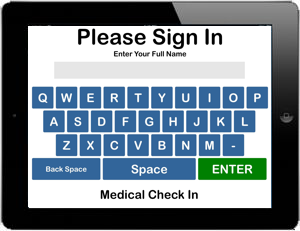


By separating patient check in from the paperwork, the process can dramatically increase the patient flow through the office. Since most patients are return patients, the only reason to fill out forms is when there are changes to their insurance or demographics. One question at the kiosk asking 'are there any changes to your account?' will prompt the receptionist to inquire about the changes.
When a new patient, who doesn't know the software, is required to use a kiosk to enter data, it will take a long time. Forms take time and it will tie up the kiosk. That same kiosk is used to check in other patients that may not need to fill out forms. This means the patients that just need to check in are waiting for the new patients to fill out forms. Now the office will need more kiosks and square footage to place them. More equipment, more space and more overhead to maintain is additional cost the office can do without.
In the end, separating the check in process from the data collection is a key to making the sign in process more efficient.
Using the patient portal frees up the medical check in kiosk and allows for the majority of patients to pass through without waiting for others to fill out paperwork.